Which Is Better Media Filter Or 1
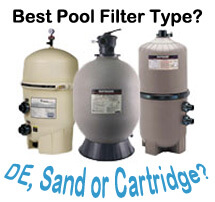 A properly sized swimming pool filter is the first and nearly of import step to maintaining clean and clear pool water. Pool filters remove dirt and droppings, which allows chlorine, bromine or other sanitizer to focus on destroying bacteria.
A properly sized swimming pool filter is the first and nearly of import step to maintaining clean and clear pool water. Pool filters remove dirt and droppings, which allows chlorine, bromine or other sanitizer to focus on destroying bacteria.
Check sizing recommendations on whichever filter blazon you cull and always go bigger if y'all can afford it; an undersized filter will just not be effective. It is ever improve to buy a larger filter than you demand, specially if you lot are on the argue betwixt two sizes.
There are 3 kinds of pool filters: sand, cartridge and DE (which stands for diatomaceous earth). All three are capable of properly maintaining the h2o. At that place is no ane best puddle filter for all applications, merely many owners accept a preference for one over the other. This will help you decide which puddle filter blazon is best for you.
Sand Filters
 Pros:Oldest and most common type of pool filter and certainly the easiest filter to operate. Out of all three filter types, a sand filter is the least expensive pool filter to purchase for your swimming pool. The cleaning of a sand filter is done by backwashing the filter, which is an easy process.
Pros:Oldest and most common type of pool filter and certainly the easiest filter to operate. Out of all three filter types, a sand filter is the least expensive pool filter to purchase for your swimming pool. The cleaning of a sand filter is done by backwashing the filter, which is an easy process.
 Cons:The sand filter will filter the puddle water to the largest particle size, approximately 20 microns. It wastes water when backwashing, a few thousand gallons per season in most cases. The sand inside the filter should be changed every 5-7 years, which is not besides difficult or expensive.
Cons:The sand filter will filter the puddle water to the largest particle size, approximately 20 microns. It wastes water when backwashing, a few thousand gallons per season in most cases. The sand inside the filter should be changed every 5-7 years, which is not besides difficult or expensive.
Sand filters are the oldest and most mutual blazon of pool filter. The filter tank is filled with a specific course of sand called No. 20 silica sand, which is available at most hardware stores or sand and gravel yards.
Water enters the tank and is pushed down through the sand, which traps dirt and droppings. The water travels all the fashion down to the bottom of the tank, where information technology enters the laterals and so is returned back into the puddle.
In the cutaway paradigm you can see the laterals at the bottom of the tank. Water filters through these slotted pipes, and then goes upwardly the heart piping to be returned to the pool. They are also bachelor with side-mounted valves and peak-mounted inspection ports.
Side mount sand filters are NSF certified, and can be used with a less restrictive Slide Valve, only are priced a scrap higher than tiptop mount sand filter models.
Sand filters are capable of filtering particles well-nigh 20-40 microns in size, which technically makes them the least effective amid the three puddle filter types in terms of the particle size removed. They are the easiest to maintain, requiring backwashing or cleaning to remove dirt from the filter when the force per unit area guess has a reading of viii-x psi over the startup reading.
Somewhen backwashing will no longer be able to remove the buildup. The sand particles will become smooth and unable to trap debris, and the sand will demand to exist replaced. On average this is required about every 5-7 years, but it tin can be much sooner for undersized sand filters. The sand probably needs to be replaced when more frequent backwashing is required and it is difficult to maintain filter pressure level at a normal level or articulate up pool water issues. For details on filter sand replacement, check out my blog post "How to Change Pool Filter Sand."
Sand filters are available for any puddle size, and they are by and large the only filter type you'll observe in large commercial applications.
Cartridge Filters
 Pros:There is no multiport valve necessary then plumbing is easier, and with no multiport valve there is no backwashing, which is environmentally friendly because it conserves water and considering DE pulverisation is non discharged. And since there is no multiport valve, there are no multiport valve repairs. Cartridges filter the water better than sand but less than DE.
Pros:There is no multiport valve necessary then plumbing is easier, and with no multiport valve there is no backwashing, which is environmentally friendly because it conserves water and considering DE pulverisation is non discharged. And since there is no multiport valve, there are no multiport valve repairs. Cartridges filter the water better than sand but less than DE.
 Cons:With a single-pleated filter inside you need to make clean the filter cartridge fairly frequently. With the large cluster type of filter, normally iv filters, you yet demand to clean the filters but only one time or twice during the pool flavor. To clean the filter cartridge or cartridges y'all open up the filter, take the cartridges out and spray them with a hose, which takes 5-30 minutes.
Cons:With a single-pleated filter inside you need to make clean the filter cartridge fairly frequently. With the large cluster type of filter, normally iv filters, you yet demand to clean the filters but only one time or twice during the pool flavor. To clean the filter cartridge or cartridges y'all open up the filter, take the cartridges out and spray them with a hose, which takes 5-30 minutes.
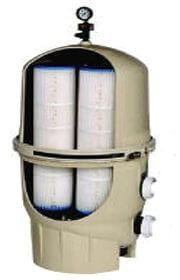 Cartridge filters are so named because they incorporate a pleated spun polyester filter cartridge that looks similar to the air filter yous will find in your motorcar. H2o is forced through the cartridge pleats and it will trap debris as modest equally v-25 microns, a significant improvement over sand filters.
Cartridge filters are so named because they incorporate a pleated spun polyester filter cartridge that looks similar to the air filter yous will find in your motorcar. H2o is forced through the cartridge pleats and it will trap debris as modest equally v-25 microns, a significant improvement over sand filters.
Cartridge filters require footling maintenance. An oversized cartridge filter only needs to be cleaned about every six months, or whenever the filter force per unit area is 8-10 psi over the standard reading.
Each time a puddle cartridge is cleaned some of its filtering ability is lost, and eventually oils and debris will build upwards to the point that they cannot be removed, so cartridges do demand to be replaced usually every iii-5 years.
Replacement pool filter cartridges vary in cost, but on average, new pool cartridges are in the $30-$100 range for each cartridge. Some filters may accept several cartridges. For more details on pool cartridge cleaning and replacement, check out my blog mail service "Pool Filter Cartridges: When to Clean and When to Replace."
DE Pool Filters
 Pros:The DE filter has the advantage of filtering the water to the smallest particle size (two-3 microns) and will continue the water cleaner than a sand filter or cartridge filter. This tin can translate to less pump run time and less sanitizer needed to keep the water clean and clear. DE is the superior class of pool filtration.
Pros:The DE filter has the advantage of filtering the water to the smallest particle size (two-3 microns) and will continue the water cleaner than a sand filter or cartridge filter. This tin can translate to less pump run time and less sanitizer needed to keep the water clean and clear. DE is the superior class of pool filtration.
 Cons:DE filters crave the nigh corporeality of maintenance. After backwashing your filter you must add together replacement DE powder through your skimmer to recoat the grids inside your pool filter. With a DE filter yous also need to have the filter autonomously every six months to clean the filter grids manually. Lastly, the DE filter is the near expensive filter to purchase.
Cons:DE filters crave the nigh corporeality of maintenance. After backwashing your filter you must add together replacement DE powder through your skimmer to recoat the grids inside your pool filter. With a DE filter yous also need to have the filter autonomously every six months to clean the filter grids manually. Lastly, the DE filter is the near expensive filter to purchase.
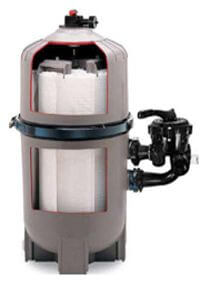 DE, or Diatomaceous Earth, filters remove particles down to 1-3 microns in size, a smaller particle size than can exist seen by the naked eye, making them the most constructive filter blazon. The filter contains either fingers or grids (grid associates shown) that is covered past a fine powder called diatomaceous earth. It is this powder that actually does the bulk of the filtering. DE powder is more often than not sold separately from the filter itself and is added by pouring it through the skimmer.
DE, or Diatomaceous Earth, filters remove particles down to 1-3 microns in size, a smaller particle size than can exist seen by the naked eye, making them the most constructive filter blazon. The filter contains either fingers or grids (grid associates shown) that is covered past a fine powder called diatomaceous earth. It is this powder that actually does the bulk of the filtering. DE powder is more often than not sold separately from the filter itself and is added by pouring it through the skimmer.
Like a sand filter, a DE filter must be backwashed when its pressure level approximate reads 8-10 psi higher up its normal reading. Backwashing will flush about of the DE pulverisation out of the filter. Your city may have sure DE disposal requirements; avoid backwashing into streams or sanitary sewer systems.
Backwashing is easily accomplished past shutting off the pump and turning the filter valve handle (multiport valve shown in image to a higher place) to the aftermath position. The dirty DE powder is flushed out of a aftermath hose (sold separately). Like side-mount valve sand filters, DE filters tin can utilise a less restrictive slide valve instead of the multiport valve for backwashing the filter.
Afterward backwashing, a new application of DE powder is added via the pool skimmer. The grids or fingers in a DE filter should as well be cleaned on an annual ground and soaked in a cleansing solution like our granular pool filter cleaner.
DE filters provide the highest water quality without a doubt, but this does come at a cost; the filters themselves are generally the most expensive and they are as well more time consuming to maintain.
FILTER EFFICIENCY:
All filters work a bit better when they are a flake dirty, hence the range of potential micron-trapping ability in our puddle filter comparison chart. A clean sand filter may filter down to only twoscore microns, simply equally clay loads upwards in the sand bed, it may effectively trap particles in the 20 micron range. All filters will maintain clear h2o in a well balanced and articulate pool, just simply those that can trap very small particles can make clean up agin water conditions apace. For leap puddle openings or algae blooms, for example, a DE filter can clean this upward in 1-ii days, but sand filters can take over a week and may need help from clarifiers or other chemicals Other factors affecting filter dirt-trapping ability include the h2o flow rate and the filter media age. High menstruation rates, college than the recommended design catamenia rate, will produce poor filtration, pushing smaller particles right through the filter. As filter sand or filter cartridges age, they lose upwardly to one-half of their dirt-trapping power and need to be replaced.
FILTER MEDIA LIFESPAN:
The tank of your puddle filter tin can terminal 25 years or more, but the filter media, the stuff inside that does the filtering, will go worn out over time, eventually becoming axiomatic in cloudy water and short filter cycles (time betwixt backwash or cleaning). Tired filter media needs longer filtration time and more than frequent cleaning or backwashing to keep the filter pressure low. You'll also need more sanitizer, clarifier and other chemicals to assist your ailing pool filter. The size of your filter volition also greatly touch on the filter media lifespan. If your filter is double the size, the filter media may terminal twice as long: half dozen years for cartridges, 10 years for sand and 15 years for DE grids.
FILTER PURCHASE Price NEW:
Anybody can understand the logic of a big pool filter, but when faced with a cost range of $500-$1,200, it's difficult to pay double the cost for something that will practise pretty much the same job. DE filters cost the most, mainly because they have so many parts, simply too remember that they do the best chore at filtering the water. Cartridge filters are cheaper than DE filters, with fewer parts, plus no split aftermath valve to buy. Sand filters are the cheapest pool filter considering they are the simplest type of puddle filter, with few parts and a simpler design to fabricate. All filters should have the aforementioned installation cost; even so, the installation of a cartridge filter is unremarkably the everyman degree of difficulty. This is considering without a filter valve, the plumbing is less complicated, and because you lot are non hauling and pouring hundreds of pounds of filter sand.
FILTER MEDIA REPLACEMENT COST:
Sand: Pool filter sand is inexpensive if you lot tin can find it locally, usually about $10 per 50 pounds. Over fourth dimension the sand volition lose its sharp edges, resulting in a filter tank filled with tiny ping pong balls! Most inground pool filters use well-nigh 300 pounds of filter sand, just a larger (recommended) sand filter can hold 500 pounds, which is still a low full cost, as long as you don't pay to take it shipped! Filter sand alternatives be, however, which are toll effective to transport such every bit PolyBALLS, ZeoSand and Filter Glass.
DE: DE filter grids are the fabric coated plastic frames. Over time, the stitching will unravel or holes tin can develop in the fabric. If y'all are handy with an awl, you can sew upwards holes, but if they are old or damaged from bad h2o chemistry, DE grid replacement is in order. Virtually DE filters accept eight grids, and complete DE grid sets are available for $100-$150 or individually for effectually $20 each.
Cartridge: Filter cartridges, similar the air cleaner in your motorcar, won't concluding forever. The fibers in the material will split over time and can develop holes- or sparse spots. It is advised to supercede pool filter cartridges after 12-xv cleanings, or inside a 3-v year timeframe. Large cartridge filters, with four 32-inch tall cartridges, can go an entire season without cleaning on some pools and tin can last six or seven years in some cases. Replacement costs for cartridges vary simply can be every bit much as $125 each for inground pool filters
Changing filter cartridges is the easiest filter media replacement, just open the tank and swap out the carts. Changing filter sand involves scooping out the sand by hand and pouring in new sand through the height access port. DE filter grid replacement involves opening the tank, removing and cleaning of the grids, followed by a complete disassembly and reassembly of the filter filigree assembly. Replacing filter sand or the DE filter grids are more than hard and fourth dimension consuming (1-2 hours), only certainly DIY-friendly.
FILTER WATER USAGE:
If you are located in a dry area with puddle water apply restrictions, your legislators may have already chosen your next pool filter for you! Cartridge filters are preferred in drought-stricken areas because they are not backwashed; instead the cartridges are removed from the tank and hosed make clean from top to lesser. This uses nigh 100 gallons or so, compared with 500 gallons (or and so) when backwashing a sand or DE filter. DE filters nevertheless, can be bumped every few weeks to reduce the need for frequent backwashing. A "bump" is a brusk aftermath, merely 10-15 seconds, which mixes upward the dirt and DE pulverization and allows y'all to go along filtering with delayed backwashing. DE filters tin can also be installed with a separation tank to filter the backwash wastewater and render it to the pool without wasting a drib. Sand filters, yet, require more frequent and longer backwashing cycles, using more wastewater than other filter types.
FILTER REPAIR FREQUENCY:
A sand filter is the simplest filter design, with fewer parts and less potential issues. It does, however, have a aftermath valve, either multiport or push-pull valve. In fact, a sand filter volition accept more than problems with the valve than it will with the tank or internal parts. DE filters have the almost internal (and external) filter parts, dozens of them and also a aftermath valve. And because a DE filter requires annual removal, cleaning and inspection of the filigree assembly, at that place are more opportunities for damage or breakage (acquired by yous, sorry). Cartridge filters don't have backwash valves and take a simple design with few parts. For this reason, information technology is likely that a cartridge pool filter volition break less frequently or require fewer repairs over time.
Fourth dimension CLEANING OR MAINTAINING:
In the ease of utilise category, sand filters are the undisputed winners. They are easy to operate and understand and easy to aftermath, and you hardly ever need to go inside the tank for any reason. DE filters, by contrast, require adding a fresh charge of DE powder after each backwash, and every vi months they will need to be opened up and hosed thoroughly and inspected for missing parts or damage. Cartridge filters can be very low maintenance when they are big enough, with cleaning needed merely every three-four months, but if minor, y'all could be opening upwardly the filter every few weeks. Cleaning cartridges is not hard, but information technology's going to be a while; wait to spend at least 10 minutes per cartridge, hosing it carefully elevation to bottom. For best results with all filter types, use a puddle filter cleaner annually to remove minerals and oily deposits.
Best Pool Filter Type
- Sand filters are least effective but also the least expensive to buy and use.
- Cartridge filters are more effective but are more than expensive to purchase and utilize.
- DE filters are the almost effective but are the well-nigh expensive to buy and use.

Determining the best filter for your pool will mean determining your feelings on h2o quality, price and maintenance. Your best pool filter may exist the largest filter y'all tin afford, no matter which filter type.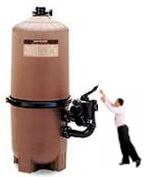
So recollect: Get large! A sand filter that is oversized for your pool is a better buy than an undersized DE filter. Larger filters crave less maintenance and the filter media lasts longer. And when y'all really need them to make clean up poor water conditions, larger pool filters volition do so faster and better than smaller. They often forestall poor water conditions in the first place.
If y'all'd like us to help you select the filter that will requite you the virtually filter size for your cadet, requite u.s. a call at 1-800-288-7946!

Jackie Wolski
InTheSwim Staff Blogger
Which Is Better Media Filter Or 1,
Source: https://blog.intheswim.com/best-pool-filter-type-de-sand-or-cartridge/
Posted by: striplinprivent.blogspot.com


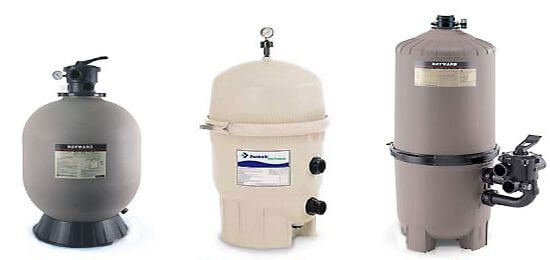


 (4 votes, boilerplate: three.50 out of 5)
(4 votes, boilerplate: three.50 out of 5)
0 Response to "Which Is Better Media Filter Or 1"
Post a Comment